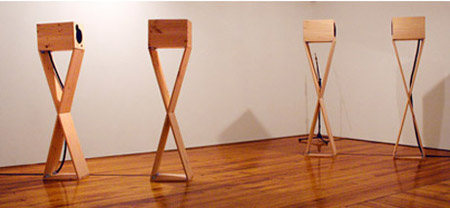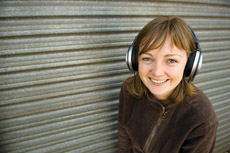noise cancellation: disrupting audio perception
 |
Cara-Ann Simpson |
if walls had earsNoise cancellation systems listen to the noise in an environment and produce the same frequency bands but with inverse polarity to eliminate unwanted sound. This works because two identical but out of phase waves of sound will cancel each other out, just as opposing waves might in the ocean. Inspired by such technologies but antithetical to them, Cara-Ann Simpson’s installation—Noise Cancellation: disrupting audio perception—transmits the noise of the environment immediately outside the gallery into its confines. Four elegant wooden constructions each house a speaker from which springs intermittent bursts of noise. It's not the white noise of television static or even the calmer pink of radio, the sea or the murmur of the city, but the identifiable sounds of engines, brakes and horns outside on Johnston Street, Fitzroy. I move in for a closer look, slowly daring to stick my head between two of the structures before realising that I've been lead into a dedicated listening position by the subtle architecture of the installation, and that the four sculptures are in fact two pairs of giant headphones. I notice a single microphone on a stand in the corner of the room and become suddenly aware of the walls at which it points. I listen intently, moving back and forth between the two stations and attempting to distinguish any influence that my own movements are having on the unpredictable bursts of noise, but each disruption only draws my attention further outside the gallery. Simpson's installation forced me to listen beyond the gallery while at the same time becoming more mindful of my place in it. It is perhaps unsurprising then that the artist cites Roland Barthes' "Listening" with its differentiation between hearing and listening—defining the former as physiological and the latter psychological—to explain the motivation behind the work. For me, the installation was a reminder that French philosopher Michel Serres wrote in "The Parasite" (1982): “we are in the noises of the world, we cannot close our door to their reception, and we evolve, rolling in this incalculable swell.” Ben Byrne Cara-Ann Simpson, Noise Cancellation: disrupting audio perception, Conical, Melbourne, Nov 21-Dec 12 |
 |
Cara-Ann SimpsoninterviewNoise Cancellation: disrupting audio perception is part of your ongoing exploration of noise and signal cancellation and audience interaction. What about these technologies particularly interests you? I want to work towards making people comfortable in galleries—to remove the highbrow myth of silent contemplation. Perhaps sound and interaction are integral within these spaces. You worked with an engineer, Eva Cheng, on this installation. What were some of the challenges you had to overcome together in realising the work and how did her input shape it? Eva and I first started planning this project with the hugely ambitious aim of creating noise cancellation in an open room environment. However, due to the acoustic nature of the room we pursued a different angle—switching people’s aural focus. Altering our ideas to suit the environment was (ironically) one of the toughest but also most rewarding challenges we faced. What affect do you hope that the installation will have on audiences? I want individuals to eliminate the need to differentiate between listening and hearing—to enter the space of the installation and consider the environmental sounds outside of the space with the same consideration and attention as to those they hear within the work. You write in your artist statement that you drew upon the ideas of the Italian Futurists and Erik Satie. How did these influence the work? The Futurists believed we should consider noises made by ourselves, machines and nature as just as essential as those made by musical instruments. Meanwhile, Satie's furniture music was about making music not to be listened to, but that merged with background noises. The installation plays on these ideas—it takes background noises, records them and switches the focus to them. Should the listener give their attention to the noises coming out of the speakers or those that appear to be recorded by the microphone in the room? What initially caused you to become interested in the act of listening and how acoustic environments affect individuals? I used to make conceptual paintings based around monochromes and hard-edge. I became more interested in the process of painting than the outcome, and began listening to how I painted. I began recording making works and placing speakers behind the works—playing the sound of the painting being painted. This kept developing as my interests became more about sound and recording the act of making. All of this coincided with the realisation that the work I was making at home, an isolated and quiet farm, was a meditative process, while the works produced in the busy and noisy university workshops were energetic and compulsive. This took me from making works about themselves to works about the space in which they are situated. This project was sponsored by the Janet Holmes à Court Artists’ Grant Scheme, supported through a donation by Mrs Janet Holmes à Court, financial assistance from the Visual Arts Board of the Australia Council and administered through NAVA, the National Association for the Visual Arts. Ben Byrne is an artist, musician, producer, writer and curator whose work traverses musical performance and improvisation, installation, composition radiophonics and sound theory. He is currently working towards a doctorate. |








 back
back